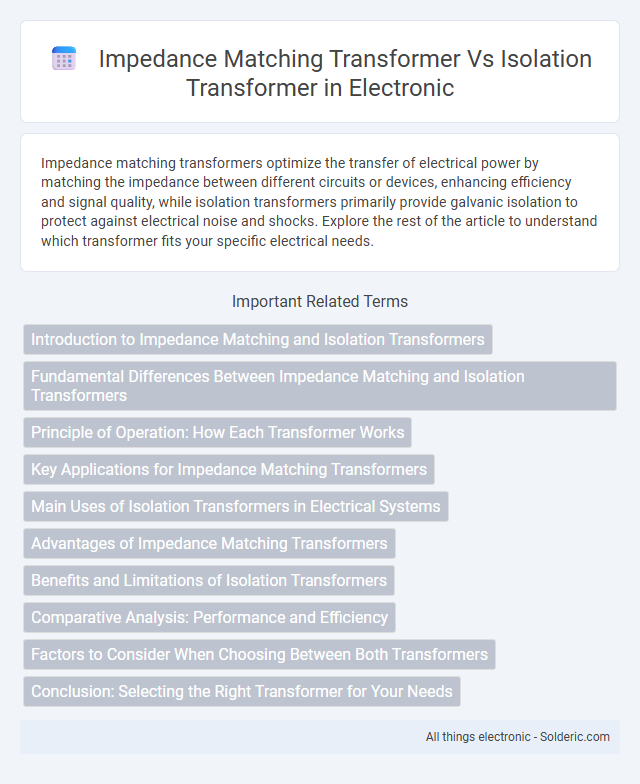Impedance matching transformers optimize the transfer of electrical power by matching the impedance between different circuits or devices, enhancing efficiency and signal quality, while isolation transformers primarily provide galvanic isolation to protect against electrical noise and shocks. Explore the rest of the article to understand which transformer fits your specific electrical needs.
Comparison Table
| Feature | Impedance Matching Transformer | Isolation Transformer |
|---|---|---|
| Primary Purpose | Match impedance between source and load for maximum power transfer | Provide electrical isolation between circuits for safety and noise reduction |
| Voltage Transformation | Yes, designed to match impedance ratios | Typically 1:1 ratio, no voltage change |
| Electrical Isolation | Provides isolation but optimized for impedance matching | Main function is isolation with galvanic separation |
| Common Applications | Audio equipment, RF circuits, antennas | Medical devices, industrial equipment, power supplies |
| Frequency Range | Wide, often optimized for specific frequencies | Broad frequency range, focus on safety and isolation |
| Core Design | May use specialized cores for minimal loss at target frequency | Typically laminated steel or ferrite for isolation |
| Safety | Secondary; focus on performance | Primary; protects against electric shock and interference |
Introduction to Impedance Matching and Isolation Transformers
Impedance matching transformers optimize power transfer between circuits by matching the source and load impedances, minimizing signal reflection and loss. Isolation transformers provide galvanic separation between circuits, enhancing safety and reducing noise by preventing direct electrical connection while maintaining signal integrity. Both transformers play critical roles in electrical systems but serve distinct functions based on impedance compatibility and circuit isolation requirements.
Fundamental Differences Between Impedance Matching and Isolation Transformers
Impedance matching transformers optimize power transfer between circuits by aligning source and load impedances, minimizing signal reflection and loss. Isolation transformers provide galvanic isolation to prevent ground loops and suppress electrical noise, enhancing safety and signal integrity. While impedance matching focuses on impedance conversion for efficiency, isolation transformers prioritize electrical separation for protection.
Principle of Operation: How Each Transformer Works
An impedance matching transformer operates by adjusting the impedance between a source and load to maximize power transfer and minimize signal reflection, using turns ratio to match impedances precisely. An isolation transformer functions by isolating two circuits electrically while transmitting power through magnetic coupling, enhancing safety and reducing noise without altering voltage levels significantly. Your choice depends on whether you need optimized power transfer or safe circuit separation.
Key Applications for Impedance Matching Transformers
Impedance matching transformers are crucial in audio equipment, RF communications, and signal processing systems to ensure maximum power transfer and minimize signal reflection by matching source and load impedances. These transformers are widely used in antenna systems, microphone inputs, and transmission lines to optimize signal integrity and reduce distortion. Their application enhances performance in both balanced and unbalanced circuit configurations across various electronic devices.
Main Uses of Isolation Transformers in Electrical Systems
Isolation transformers are primarily used to decouple electrical equipment from the power source, enhancing safety by preventing direct electrical contact and reducing the risk of electric shock. They provide galvanic isolation to protect sensitive devices from voltage spikes, electrical noise, and ground loops in industrial and medical applications. Unlike impedance matching transformers, isolation transformers do not alter voltage or impedance levels but focus on isolating and protecting circuits.
Advantages of Impedance Matching Transformers
Impedance matching transformers optimize power transfer by minimizing signal reflection and ensuring maximum efficiency between different circuit components, which is especially crucial in audio and RF applications. Their ability to match varying impedance levels helps maintain signal integrity and reduce distortion, enhancing overall system performance. You benefit from improved compatibility and reduced power losses compared to isolation transformers, which primarily focus on galvanic isolation rather than impedance adaptation.
Benefits and Limitations of Isolation Transformers
Isolation transformers provide electrical isolation between the input and output, enhancing safety by preventing direct current flow and reducing the risk of electric shock. They effectively minimize electrical noise and ground loops, improving signal quality in sensitive electronic equipment. However, isolation transformers typically do not match impedance levels, limiting their use in applications requiring impedance transformation for optimal power transfer.
Comparative Analysis: Performance and Efficiency
Impedance matching transformers optimize signal transfer by minimizing reflection and power loss between circuits with different impedances, enhancing overall system performance. Isolation transformers provide electrical separation between primary and secondary circuits, improving safety and reducing noise without necessarily optimizing impedance or efficiency. In terms of efficiency, impedance matching transformers typically yield higher power transfer efficiency, while isolation transformers prioritize safety and noise reduction over maximum energy efficiency.
Factors to Consider When Choosing Between Both Transformers
When choosing between an impedance matching transformer and an isolation transformer, consider the primary function each serves: impedance matching transformers optimize power transfer by aligning source and load impedances, while isolation transformers provide galvanic isolation to prevent ground loops and enhance safety. Evaluate the application requirements such as signal integrity, noise reduction, and voltage level adjustments, as impedance matching transformers excel in audio and RF circuits, whereas isolation transformers are critical in medical equipment and sensitive electronics environments. Cost, size, frequency range, and regulatory compliance also influence the choice, with isolation transformers typically offering higher insulation standards and impedance matching transformers tailored for specific impedance ratios.
Conclusion: Selecting the Right Transformer for Your Needs
Impedance matching transformers are designed to maximize power transfer by matching the source and load impedances, ideal for audio systems and RF applications. Isolation transformers provide galvanic isolation to protect equipment and reduce noise, commonly used in electrical safety and sensitive electronics. Your choice depends on whether optimizing signal transfer or ensuring electrical isolation is the priority in your specific application.
impedance matching transformer vs isolation transformer Infographic

 solderic.com
solderic.com